Are you curious about where birds fly to in winter? The journey of migratory birds is a captivating phenomenon, and at flyermedia.net, we’re here to explore the fascinating world of avian migration, offering insights into their destinations, navigational skills, and the challenges they face. Discover the wonders of bird migration, from the long-distance travelers to the short-distance shifters, and gain a deeper appreciation for these incredible journeys. Uncover the secrets of bird flyways, migration hazards, and the science behind their navigation with flyermedia.net.
Table of Contents
- Why Do Birds Migrate?
- What Prompts Birds to Start Migrating?
- How Variable Is Migration Timing?
- Do Adult and Juvenile Birds Migrate Together?
- What’s the Best Time of Day to Migrate?
- How Can People Help Migrating Birds?
- What are the Types of Migration?
- What are the Origins of Long-Distance Migration?
- How to Get Your BirdCast?
- What Triggers Migration?
- How Do Birds Navigate?
- What are the Migration Hazards?
- How to Study Migration?
- What Is a Migrant Trap?
- What are Range Maps?
- FAQ about Bird Migration
1. Why Do Birds Migrate?
Birds migrate to move from areas of low or decreasing resources to areas of high or increasing resources, primarily for food and nesting locations. Dr. Kevin McGowan from the Cornell Lab highlights that migration is driven by the need to find food, as many birds rely on flying insects or moving insects that are scarce in certain regions during winter. While cold weather is a factor, the primary motivation is access to ample food supplies. Bird migration is almost always about finding food.
To elaborate, birds that nest in the Northern Hemisphere migrate northward in the spring to exploit burgeoning insect populations, budding plants, and an abundance of nesting locations. As winter approaches and food availability drops, they move south again. This behavior isn’t solely about escaping the cold; many species, like hummingbirds, can endure freezing temperatures if they have enough food.
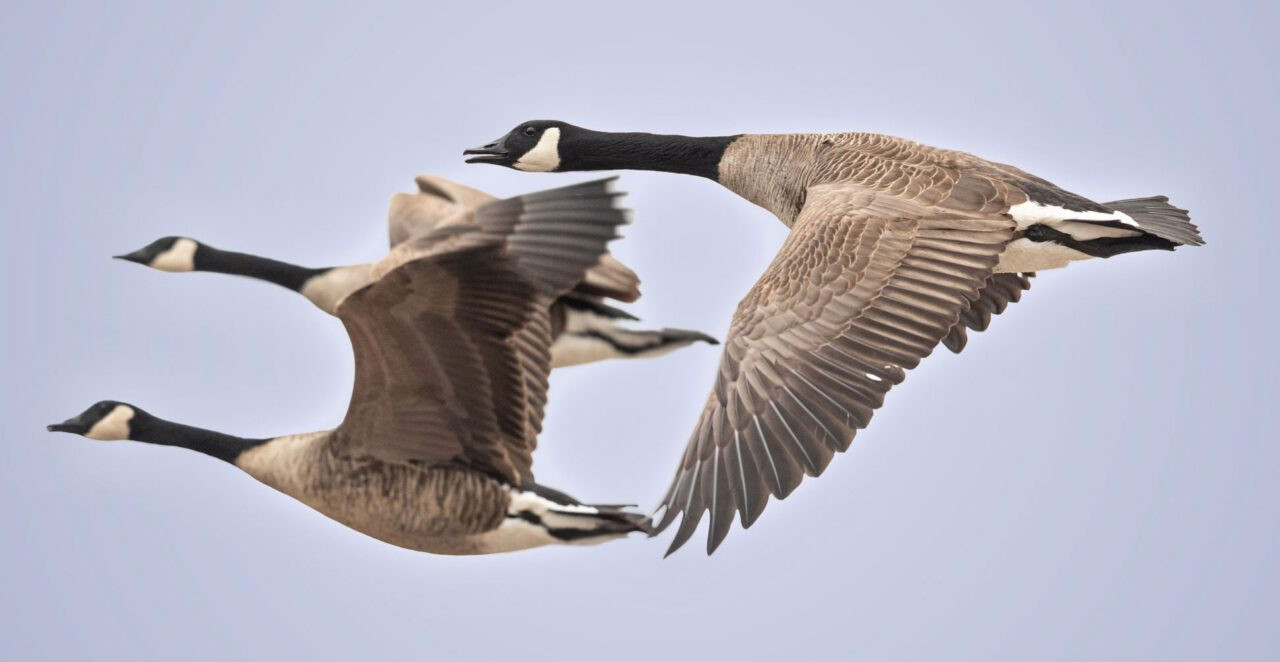 Canada Geese flying in V-formation
Canada Geese flying in V-formation
Canada Geese by Brad Imhoff / Macaulay Library
Understanding the reasons behind bird migration helps us appreciate the complexity of their behavior and the environmental factors that influence their movements. For example, geese flying south in V-shaped flocks are a classic image of migration, but they are just one example of the many species that undertake these journeys. According to research from Cornell Lab of Ornithology, over half of the more than 650 species of North American breeding birds are migratory. This highlights the widespread nature of migration and its importance for bird populations.
Flyermedia.net offers valuable resources for those seeking to understand the nuances of avian behavior and migration patterns, helping to make informed decisions about conservation efforts and personal enjoyment of birdwatching.
2. What Prompts Birds to Start Migrating?
Migration is usually triggered by changes in daylight, which affect the birds’ brains and hormone production. Dr. Kevin McGowan explains that birds can sense even small changes in daylight length, initiating a physiological response that leads to migratory restlessness, known as “Zugunruhe” in German.
Zugunruhe is a well-studied phenomenon where birds in captivity become restless as daylight changes, indicating an innate drive to migrate. This restlessness demonstrates the powerful influence of environmental cues on migratory behavior.
In detail, the decrease in daylight hours signals to birds that it’s time to prepare for migration. This change prompts hormonal shifts that stimulate the urge to fly south in search of more favorable conditions. According to research from the University of California, Berkeley, the pineal gland in birds responds to changes in light exposure, regulating the production of melatonin, a hormone that influences migratory behavior.
Flyermedia.net provides current information on these triggers and the underlying science, ensuring enthusiasts and professionals alike can stay informed about the latest discoveries in avian biology.
3. How Variable Is Migration Timing?
Migration timing is fairly rigorous for some species but can vary depending on weather and local conditions. As Dr. Kevin McGowan points out, the arrival of Red-winged Blackbirds in central New York is consistently within a two-week period. However, individual birds may adjust their migration based on weather changes and local conditions, resulting in some fine-tuning of their schedules.
This variability highlights the adaptability of birds to changing environmental conditions. While some species follow predictable schedules, others are more flexible, adjusting their migration based on real-time factors.
For example, a study by the National Audubon Society found that climate change is causing shifts in migration timing for many bird species, with some birds arriving at their breeding grounds earlier than in the past. These shifts can have cascading effects on ecosystems, impacting the availability of food resources and the timing of nesting.
Flyermedia.net offers updated data on migration patterns and timing, aiding birdwatchers and researchers in tracking these dynamic changes.
4. Do Adult and Juvenile Birds Migrate Together?
Adult and juvenile birds typically do not migrate together; males often leave the breeding grounds before females and juveniles. Generally, adults leave first, followed by juveniles who may need more time to fatten up for the journey.
This staggered migration pattern ensures that experienced birds can take advantage of the best resources along the way, while younger birds have time to prepare for the arduous journey.
For instance, research from the Smithsonian Migratory Bird Center indicates that adult birds often have established migration routes and stopover sites, giving them an advantage over juveniles making their first migration. This knowledge helps them navigate more efficiently and find the best feeding areas.
Flyermedia.net offers detailed analysis on the different migration strategies employed by various age groups and sexes within bird species.
5. What’s the Best Time of Day to Migrate?
The bulk of migration happens at night for many birds, as there are fewer predators and the opportunity to use their magnetic sense to navigate. As Dr. Kevin McGowan explains, migrating at night reduces the risk of predation and allows birds to conserve energy by foraging during the day and flying when it’s cooler.
The ability to sense the Earth’s magnetic fields is a crucial adaptation for nocturnal migrants. This sense allows them to maintain their direction even in the absence of visual cues, helping them navigate long distances with accuracy.
According to a study by the University of Lund, birds can detect magnetic fields through specialized cells in their eyes, which contain light-sensitive proteins that respond to magnetic fields. This “magnetic vision” is thought to play a key role in their ability to navigate at night.
Flyermedia.net offers scientific insights into how birds use their senses, including magnetic fields, to navigate during migration.
6. How Can People Help Migrating Birds?
People can help migrating birds by providing hummingbird feeders, offering suet, turning off lights at night, and planting native plants. Dr. Kevin McGowan suggests maintaining hummingbird feeders to provide a cheap energy source, offering suet for other birds, and reducing light pollution to prevent confusion during migration.
These actions can significantly reduce the challenges that birds face during migration, providing them with essential resources and minimizing hazards.
For example, the Cornell Lab of Ornithology’s BirdCast program encourages cities to reduce light usage during peak migration times, as light pollution can disorient birds and lead to collisions with buildings. Planting native plants provides food and shelter for migrating birds, while hummingbird feeders offer a quick energy boost.
Flyermedia.net highlights practical steps individuals and communities can take to support bird migration, including participating in citizen science projects and advocating for bird-friendly policies.
7. What are the Types of Migration?
Migration patterns vary by distance:
- Permanent residents: Birds that do not migrate and find food year-round.
- Short-distance migrants: Birds that make small movements, often altitudinal.
- Medium-distance migrants: Birds that cover distances spanning a few hundred miles.
- Long-distance migrants: Birds that travel from breeding ranges in the United States and Canada to wintering grounds in Central and South America.
The diversity in migration patterns reflects the varying strategies birds use to adapt to seasonal changes in resource availability. Short-distance migrants may simply move to lower elevations to avoid harsh winter conditions, while long-distance migrants undertake extensive journeys to find suitable climates and food sources.
For instance, Northern Cardinals are permanent residents, staying in the same area year-round, while Magnolia Warblers are long-distance migrants, traveling thousands of miles between their breeding and wintering grounds.
Flyermedia.net categorizes migration patterns, offering detailed information on the distances and routes taken by different species.
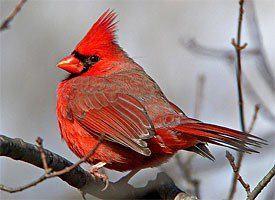 Northern Cardinal
Northern Cardinal
Northern Cardinal
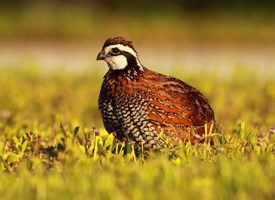 Northern Bobwhite
Northern Bobwhite
Northern Bobwhite
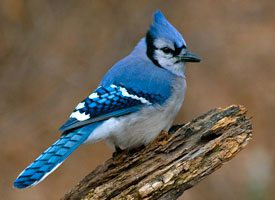 Blue Jay
Blue Jay
Blue Jay
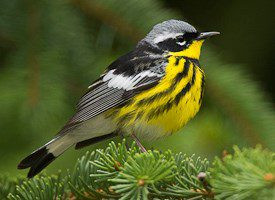 Magnolia Warbler
Magnolia Warbler
Magnolia Warbler by Gerrit Vyn
8. What are the Origins of Long-Distance Migration?
Long-distance migration likely evolved over thousands of years, influenced by genetic makeup, weather, geography, food sources, and day length. One theory suggests that tropical ancestors of migratory birds dispersed northward to take advantage of seasonal food abundance and longer day lengths, which allowed them to raise more young. As their breeding zones moved north during glacial retreat, they continued to return to their tropical homes during winter.
This theory is supported by the fact that many North American vireos, flycatchers, tanagers, warblers, orioles, and swallows evolved from forms that originated in the tropics.
According to research from the University of Chicago, the genetic basis of migration is complex, involving multiple genes that regulate migratory behavior, navigation, and physiology. These genes have evolved over time to enable birds to undertake long-distance journeys with precision and efficiency.
Flyermedia.net delves into the evolutionary origins of migration, presenting research on the genetic and environmental factors that have shaped this behavior.
9. How to Get Your BirdCast?
BirdCast uses radar to create real-time maps of nocturnal bird migration and predict busy migration nights with 3-day forecasts. This information helps with conservation decisions, such as wind turbine placement, and allows cities to reduce building lights to prevent bird deaths.
Accurate migration models can also inform researchers about the behavioral aspects of migration, how migration timing and pathways respond to changing climate, and whether linkages exist between variation in migration timing and subsequent changes in bird population size.
BirdCast data is valuable for understanding and predicting bird movements. By accessing real-time migration maps and forecasts, individuals and organizations can take steps to protect birds during migration.
Flyermedia.net offers resources to access and interpret BirdCast data, empowering users to make informed decisions about bird conservation.
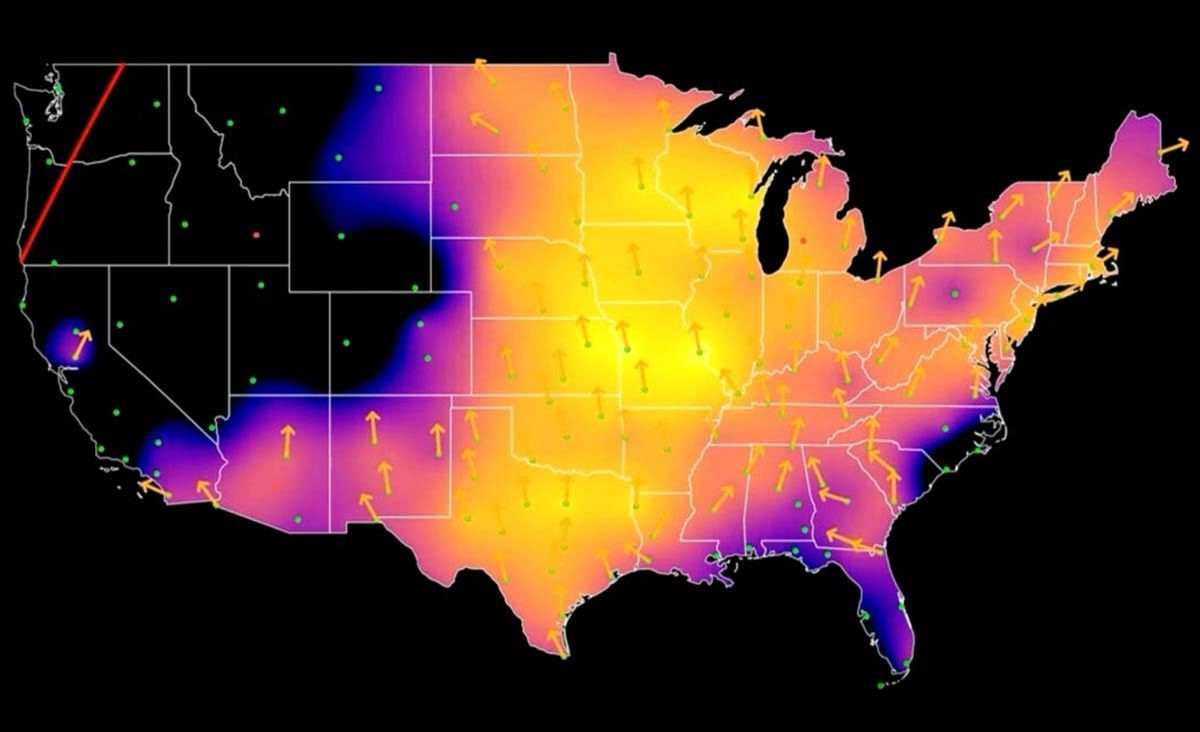 Map of the continental U.S. showing intensity of bird migration, 2021
Map of the continental U.S. showing intensity of bird migration, 2021
10. What Triggers Migration?
Migration is triggered by a combination of changes in day length, lower temperatures, changes in food supplies, and genetic predisposition. The term zugunruhe, or migratory restlessness, describes the period of agitation that migratory species experience each spring and fall.
These triggers interact to initiate the complex physiological and behavioral changes that prepare birds for migration. While day length is a primary cue, other factors can fine-tune the timing and intensity of migration.
According to research from the Max Planck Institute for Ornithology, birds have internal clocks that regulate their migratory behavior, but these clocks are also influenced by external cues such as weather patterns and food availability.
Flyermedia.net details the various factors that trigger migration, providing a comprehensive understanding of this complex process.
11. How Do Birds Navigate?
Migrating birds navigate using a combination of the sun, stars, the Earth’s magnetic field, the position of the setting sun, and landmarks. First-year birds often make their first migration on their own, relying on innate navigational abilities.
The ability to combine different types of sensory information is crucial for successful navigation. Birds can use the sun and stars as compasses, sense the Earth’s magnetic field to determine direction, and recognize landmarks to stay on course.
A study by Lund University found that birds use polarized light to navigate, which helps them maintain their orientation even when the sun is obscured by clouds. This ability, combined with their magnetic sense and visual memory, allows them to navigate with remarkable precision.
Flyermedia.net explores the fascinating ways birds navigate, offering insights into their sensory abilities and navigational strategies.
12. What are the Migration Hazards?
Migration hazards include physical stress, lack of adequate food, bad weather, increased exposure to predators, communication towers, and tall buildings. Many birds are attracted to the lights of tall buildings and are killed in collisions each year.
These hazards can significantly reduce the survival rates of migrating birds. Physical exhaustion, starvation, and predation take a toll on their populations, while human-made structures pose a growing threat.
The Fatal Light Awareness Program (FLAP) in Toronto and BirdCast’s Lights Out project address the problem of bird collisions with buildings by advocating for reduced light pollution during migration.
Flyermedia.net raises awareness about the dangers birds face during migration and highlights efforts to mitigate these threats.
13. How to Study Migration?
Scientists study migration using banding, satellite tracking, and lightweight devices known as geolocators to locate important stopover and wintering locations. Once identified, steps can be taken to protect these key locations.
These methods provide valuable data on bird movements, behavior, and habitat use. Banding allows researchers to track individual birds over time, while satellite tracking and geolocators provide detailed information on their migration routes and stopover sites.
The Central Platte River Valley in Nebraska, used by approximately 500,000 Sandhill Cranes and some endangered Whooping Cranes as a staging habitat, is an example of a critical stopover location that has been identified and protected through scientific study.
Flyermedia.net showcases the latest research on bird migration, offering insights into the methods and findings of scientists studying these incredible journeys.
14. What Is a Migrant Trap?
Migrant traps are locations that concentrate migrating birds in larger than normal numbers, often due to local weather conditions, food abundance, or topography. Examples include live-oak groves on barrier islands along the Gulf Coast, where exhausted birds seek food and cover after flying over the Gulf of Mexico. Peninsulas like Point Pelee, Ontario; the Florida Keys; Point Reyes, California; and Cape May, New Jersey also concentrate migrating birds.
These areas become popular birding hotspots as they offer unique opportunities to observe a variety of species in one location. They also serve as critical refueling stations for migrating birds, providing them with the resources they need to continue their journey.
The High Island, Texas, is a prime example of a migrant trap, attracting a diverse array of songbirds after their spring journey across the Gulf of Mexico.
Flyermedia.net identifies and describes migrant traps, helping birdwatchers and researchers locate these important areas.
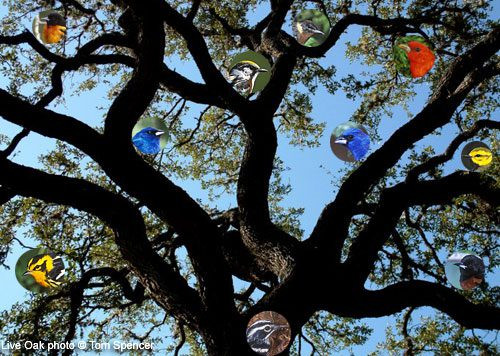 Illustration of a tree with images of different birds
Illustration of a tree with images of different birds
15. What are Range Maps?
Range maps in field guides indicate if and when a particular species might be present in an area. However, ranges can vary year-to-year, and some species’ ranges can expand or contract rapidly. Data-driven, digital versions of range maps, made possible by eBird observations, provide more up-to-date information on species’ distributions.
These digital maps show a species’ ebb and flow across the continent throughout the year, allowing for a better understanding of larger patterns of movement.
The Eurasian Collared-Dove is an example of a species whose range has expanded rapidly, making traditional range maps outdated. EBird data provides a more accurate picture of its current distribution.
Flyermedia.net offers access to data-driven range maps, ensuring users have the most accurate information on species’ distributions and movements.
16. FAQ about Bird Migration
Here are some frequently asked questions about bird migration:
- Why do birds migrate? Birds migrate to find food and nesting locations in areas with abundant resources.
- What triggers bird migration? Changes in day length, temperature, food supplies, and genetic predisposition trigger migration.
- How do birds navigate during migration? Birds use the sun, stars, Earth’s magnetic field, and landmarks to navigate.
- What are the main hazards birds face during migration? Hazards include physical stress, lack of food, bad weather, predators, and collisions with human-made structures.
- How can I help migrating birds? You can help by providing food, water, and shelter, reducing light pollution, and supporting conservation efforts.
- Do all birds migrate? No, some birds are permanent residents and do not migrate.
- How far do birds migrate? Migration distances vary, ranging from short movements to long journeys spanning thousands of miles.
- What is BirdCast? BirdCast is a program that uses radar to create real-time maps of nocturnal bird migration and predict busy migration nights.
- What is a migrant trap? A migrant trap is a location that concentrates migrating birds in larger than normal numbers.
- How do scientists study bird migration? Scientists use banding, satellite tracking, and geolocators to study bird migration.
By addressing these common questions, Flyermedia.net provides a valuable resource for those seeking to learn more about bird migration.
In conclusion, bird migration is a fascinating and complex phenomenon driven by a combination of environmental factors, genetic predispositions, and learned behaviors. By understanding the reasons behind migration, the challenges birds face, and the strategies they use to navigate, we can better appreciate and protect these incredible creatures. Flyermedia.net offers a wealth of information on bird migration, from the latest research to practical tips for helping birds along their journey.
Ready to explore the skies? Visit flyermedia.net now to discover more about flight training, aviation news, and career opportunities in the aviation industry. Take the first step towards your aviation dreams today Address: 600 S Clyde Morris Blvd, Daytona Beach, FL 32114, United States. Phone: +1 (386) 226-6000. Website: flyermedia.net.